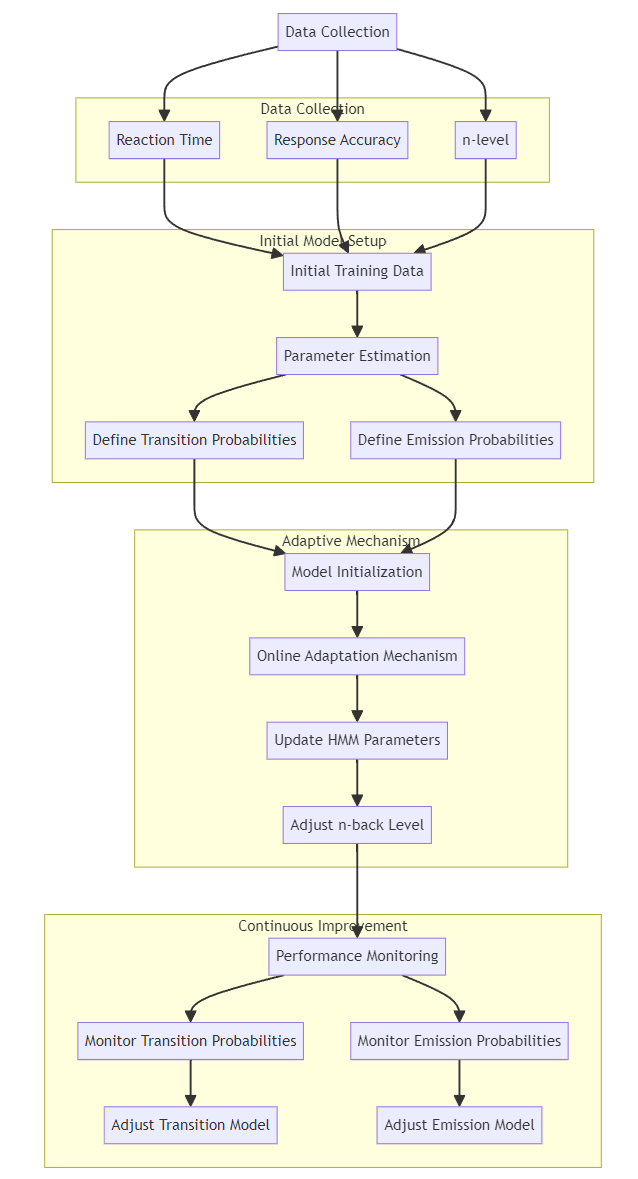Adaptive n-back task using Hidden Markov Models (HMM) based on reaction time and response accuracy, follow these steps:
Process Overview
- Data Collection:
- Reaction Time: Record the time taken for each response.
- Response Accuracy: Record whether each response is correct or incorrect.
- n-level: Keep track of the current n-back level during each trial.
- Defining States and Observations:
- States: These represent the different n-back levels (e.g., n = 1, 2, 3, …).
- Observations: These include reaction time and response accuracy.
- Transition Model:
- Define the probability of transitioning from one n-back level to another based on the current state’s performance metrics.
- If accuracy is between 80-100%, increase the n-back level.
- If accuracy is below 50%, decrease the n-back level.
- For intermediate accuracies, keep the current n-back level or slightly adjust based on additional metrics like reaction time.
- Emission Model:
- Define the probability distribution of observations (reaction time and accuracy) for each n-back level.
Required Data
- Initial Training Data:
- Collect data from a large number of trials at each n-back level to estimate the emission probabilities. This could involve thousands of trials across multiple participants to ensure robust statistics.
- Online Adaptation:
- Continuously update the model with new data during the training process to refine transition and emission probabilities.
Steps to Develop the Algorithm
- Data Preparation:
- Collect initial data for each n-back level to estimate initial parameters of the HMM.
- Ensure data includes a diverse set of reaction times and accuracy levels for each n-back level.
- Parameter Estimation:
- Use the collected data to estimate the initial transition probabilities and emission probabilities for the HMM.
- Initial transition probabilities can be set based on heuristic rules (e.g., increase n-back level if accuracy > 80%).
- Model Initialization:
- Initialize the HMM with the estimated parameters.
- Define the initial state distribution (e.g., start with n = 1).
- Online Adaptation Mechanism:
- After each trial, update the HMM parameters using the latest reaction time and accuracy data.
- Adjust the n-back level based on the current state’s transition probabilities.
- Performance Monitoring:
- Continuously monitor the performance of the HMM.
- Make adjustments to the transition and emission models if certain n-back levels are consistently over or under-performing.
Example Data Structure
- Reaction Time: Continuous variable representing the time taken for each response.
- Response Accuracy: Binary variable indicating correct (1) or incorrect (0) response.
- n-level: Integer representing the current n-back level during the trial.
Amount of Data Required
- Initial Training: At least a few hundred trials per n-back level, preferably more, to ensure robust estimation of emission probabilities.
- Online Adaptation: Continually collect data during each session to update the model.
Verification
- Verify the algorithm against study requirements by comparing the adaptive n-back levels and performance metrics with expected outcomes from previous research studies.
- Ensure the model’s predictions align with established cognitive training protocols and adapt dynamically based on participant performance.
By following this structured approach, you can develop an adaptive n-back task using Hidden Markov Models that adjusts based on reaction time and response accuracy.


As a research scientist specialising in cognitive neuroscience and psychology, I write a blog that explores the fascinating world of computational modelling and gamified Working Memory training. Through my writing, I share insights from my research on how these interventions affect learning and cognitive functions in both typically developing individuals and clinical populations. My blog delves into cognitive rehabilitation for people with brain injuries, neurodegenerative disorders, and neurodevelopmental conditions. I also discuss my work on assessing cognition, emotion, and behaviour, as well as understanding the biopsychosocial factors that impact everyday cognitive abilities. By translating complex scientific concepts into accessible content, I aim to provide a valuable resource for professionals and the general public interested in brain health and cognitive science.
Dorota Styk
The Author
